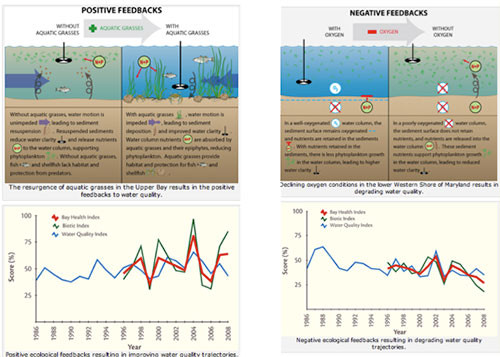Brisbane 2011: Living with Floods and Dancing with Dugongs: Part 10- Progress in Monitoring and Management
Bill Dennison ·That was the 'Living with Floods' part of the talk, and now I would like to transition to the second part, which is to talk about the impacts of this flood and the impacts on the natural resources, which translate into Moreton Bay. And I'm going to start with a story about the Chesapeake Bay. The Chesapeake Bay is the best-studied estuary in the world. It is 300 kilometers top to bottom. What we did is we emulated the Moreton Bay report card and started picking out some indicators that we could measure. Bay wide we had three water quality indicators and three biotic indicators that we combined into an index that we combined into a report card. Low and behold we learned that "Wow, some of these areas are surprisingly good," and they're way at the top, which was a surprise. And these areas, that are very rural and sparsely populated, were in very bad condition which turns out to be a chicken manure problem. These report cards allowed us to document the trajectory of the health of the bay, because the bay has been extensively studied. We had some good monitoring starting in the mid-eighties (we only started monitoring Moreton Bay in the 2000's). So we can go back several decades and we can, very clearly, see the impact of the 2003 flood, and we can see the slow recovery. So the impact is very rapid, but the recovery is very slow. My prediction for Moreton Bay is that this next report card is going to be degraded, but more importantly it's probably going to take some time to recover.
The other thing that we started analyzing was that good areas were getting better, so we can go back and plot the trajectory of areas that were actually improving, versus areas that were degrading. So we started thinking, why is that? In fact our governor, Martin O’Malley asked us that question. He said "Take me over to the area getting better, show me this, and tell me why because I want to emulate this. I don't want the negative trajectory." Well, it turned out that this area in northwestern Chesapeake Bay had done some sewage upgrades, and some quiet engineering to reduce the overflows. It had a resurgence in seagrass, which created a large nutrient and sediment sponge with what was essentially a large filter feeder. The classic waterman, who had been fishing there for four hundred years were saying that this was the clearest they had ever seen it. The seagrass was very responsive and now in the upper areas we’re seeing tremendous resilience to floods as well. That's a really positive story. So reestablishing seagrass is a game changer. The other game changer is not so pretty, and that is when the water goes anoxic. This is when you lose oxygen in the water column down to the sediment surface. Which means that the sediments, instead of providing a little cap that stops nutrients from going out, suddenly the nutrients are squirting out of the water, fueling more algae blooms, depositing more organic material, reducing more oxygen in a downward death spiral. So we’ve got these two trajectories that are game changers that we need to think about for Moreton Bay - seagrasses and water quality, and sediments.

This blog post was created from a presentation by Bill Dennison, delivered at the historic Customs House in Brisbane, Australia on 8 July, 2011 (full powerpoint presentation can be accessed on IAN Press.
About the author
Bill Dennison

Dr. Bill Dennison is a Professor of Marine Science and Vice President for Science Application at the University of Maryland Center for Environmental Science.


